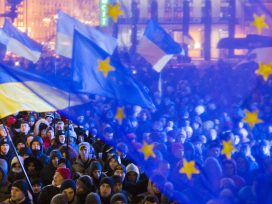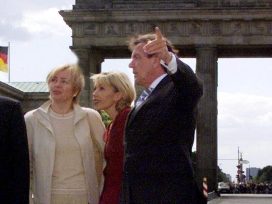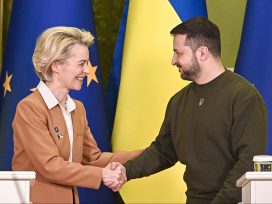The making and unmaking of revolutions
What 1917 means for Ukraine, in light of the Maidan
This year marks 100 years since the momentous revolutions in Russia in 1917. The Russian government’s stance on the anniversary is deeply ambivalent, but 2017 offers Ukraine a chance to explore its own centenary of (short-lived) independence, as well as other parts of its national story, as Tatiana Zhurzhenko explains.
One hundred years after the October Revolution, Russia is haunted by the spectre of yet another revolution, one which happened just three years ago in a neighbouring country: the Euromaidan. In fact, by 2004 ‘Maidan’ had, in Russia, already become a synonym for ‘manufactured revolution’ – a regime change imposed from outside with the help of ‘political technology’. Hardly any other event has shaped the nature of Putin’s politics as much as the Orange Revolution of November 2004, which revealed internal and external threats to his semi-autocratic regime. In the year of its centenary, the October Revolution itself appears as the original ‘Maidan’ – a German conspiracy aimed at destabilizing the Russian state by smuggling radical elements into the country. For some commentators, the original sin of the ‘Maidan’ can be found even earlier, in the February Revolution of 1917, which from their perspective was a complot of liberals against the Russian monarchy.1 The new conservative consensus in post-Crimea Russia condemns the very notion of revolution, which is equated to a crime against the state (the latter often being undistinguishable from the current regime and the ruling elite). This might be the main reason why there is no officially approved narrative of the October Revolution in today’s Russia, and the 100th anniversary of this historical event is being marked only by a couple of academic conferences.
In Ukraine, by contrast, revolution has recently become a fashion, though it has little to do with October 1917. The emerging post-Maidan political nation identifies itself with and through the Euromaidan, or Revolution of Dignity. This latest and most dramatic Ukrainian revolution invested previous protest movements – the ‘Granite Revolution’ of 1990,2 the ‘Ukraine without Kuchma’ movement in 2000/01, the Orange Revolution of 2004 (often counted as the first ‘Maidan’) – with new meaning and integrated them into a new narrative of post-Soviet Ukrainian history. The newest version of that history can now be read as a sequence of revolutions, with the Maidan – Kyiv’s central square – as an urban palimpsest of mass protest. This narrative is about freedom, solidarity and people’s empowerment, but is also about choosing Europe as a political goal and the ability of people to defend their choice.
But there is also a different narrative, which the Kremlin eagerly subscribes to, namely that the last Maidan revolution was virtual state failure, and that the country’s recurrent revolutions merely serve to demonstrate the notorious inability of Ukrainians to build a functioning state. In Ukraine, this narrative is attributed to Russia’s hybrid war. With the ongoing restoration of the oligarchic regime in Ukraine, however, fears are growing of a ‘third Maidan’ which threatens to plunge the country into chaos and to destroy its fragile political institutions – echoing the events of a century ago. Indeed, the events of 1917-21 laid the foundations of a modern Ukrainian state, but internal conflicts among the Ukrainian elites at the time were among the factors that prevented the accomplishment of that project.3
The revolution of 1917-21 plays an important part in the most recent chapter in the history of Ukrainian memory politics, which began in 1991. The official commemorative politics of the Ukrainian government and the Institute for National Remembrance (UINP)4 integrate the Maidan revolution and the continuing fight against the aggression in the east into a broadly accepted narrative of struggle for national liberation. From this perspective, the Maidan is a continuation of the Ukrainian Revolution of 1917-21 which was defeated by Bolshevik Russia. This view fits in seamlessly with the official politics of decommunization that started in 2015 and is aimed at removing Soviet symbols and banning Communist ideology, and thus appears to be the final act of decolonization for those in Ukraine who believe that a hundred years later history has given the Ukrainian nation a second chance.
This article seeks to analyse the commemorative politics related to 1917 in Ukraine against the current political background complicated by the Maidan Revolution and the Russian aggression in Ukraine. The first section deals with the new official narrative of the ‘Ukrainian Revolution 1917-21’ as an attempt to create an independent Ukrainian state, and with the commemorative initiatives taken by the president, the UINP and other institutions. The second section addresses controversies around current decommunization policies and seeks to explain the residual charm of the October Revolution 1917 in Ukraine, which symbolizes an alternative to post-Soviet capitalism. This section also deals with the political uses of Soviet symbolism in the collective identity building of the so-called Donetsk and Luhansk Peoples’ Republics (DNR and LNR) and particularly the integration of the October Revolution into their founding myth. In the conclusion, I will offer some thoughts on how the Maidan fits into the political imagination of a post-Cold War Europe which defines itself by another revolution – 1989 – whose achievements are meanwhile under threat.

Poster for the Ukrainian Institute of National Remembrance (UINP) exhibition ‘The Brave Ones: Our Heroes’. Source: UINP
1. Making the ‘Ukrainian century’: From the Ukrainian Revolution 1917-21 to the Maidan 2013-14
The relatively short, but extremely complex and dramatic period of 1917-21 in Ukraine was considered in Soviet historiography a regional version of the Russian revolution and civil war. The Ukrainian state-building experiments of those years were enabled by the collapse of the Russian empire. They ranged from the democratic and socialist Ukrainian People’s Republic (UNR), with Mykhailo Hrushevsky heading the Central Rada; to the German-backed Hetmanate of Pavlo Skoropadsky, which tended to monarchy; to the restored UNR in the form of the provisional Directorate under Symon Petliura’s leadership; and also the Western Ukrainian People’s Republic which emerged from the ruins of the Habsburg Empire. These were all dismissed by Soviet historians under the rubric of ‘Ukrainian bourgeois nationalism’; it was only in the late 1980s that ideological taboos were broken and the blank spots in Ukraine’s 20th-century political history started to attract broad public interest and the attention of professional historians.
The narrative of the ‘Ukrainian Revolution 1917-21’ was created mainly by its protagonists after they went into emigration following its failure. The two main approaches to the history of the Ukrainian Revolution were rooted in two different antagonistic groups inside the Ukrainian emigrant milieu – political supporters of Symon Petliura and of Hetman Pavlo Skoropadsky, respectively. The ‘populist’ (narodnyki) school connected with the UNR explained the failure of the Ukrainian Revolution by the low national and political consciousness of the local population, while the ‘statists’ (derzhavnyki) saw the cause of the defeat in the low quality of the Ukrainian elites (and in the socialist ideology of the UNR leaders, which alienated them from the business elites). The socialist dimension of the Ukrainian Revolution was later marginalized in the diaspora historiography, which emphasised its national liberation aspect; the revolution’s leaders – many of whom, such as Symon Petliura, had socialist views – were reimagined as primarily nation and state builders. This tendency corresponded with the developments in Soviet historiography which, from the 1930s, avoided the very notion of the ‘Ukrainian Revolution’ and declared the Bolsheviks the only legitimate bearers of the socialist tradition.
Looking back from a distance of one hundred years, the revolution 1917-21 failed to reach its goals, but at the same time it laid the cornerstones of the modern Ukrainian political nation and restored the tradition of Ukrainian statehood. As Yaroslav Hrytsak noted, to tame the Ukrainian national liberation movement the Bolsheviks were forced to grant Ukraine at least formal statehood – the Ukrainian Soviet Socialist Republic.5 In the pre-Stalinist period, the Ukrainian SSR attracted the sympathies and hopes of many emigrants by combining Ukrainization with socialism; it also gave rise to the unprecedented cultural renaissance of the 1920s and the phenomenon of Ukrainian modernism in arts, literature and architecture. While some left aspirations could be accommodated in the project of a Soviet Ukraine, the Ukrainian Revolution also gave rise to another political tradition, namely the Ukrainian nationalism in interwar Poland whose radical wing brought about the Ukrainian Insurgent Army (UPA) and the mass anti-Soviet resistance in western Ukraine which lasted until the early 1950s. As we will see later, the Euromaidan and the subsequent political developments in Ukraine (including decommunization) have rekindled the old dispute about whom the Ukrainian Revolution belongs to – the left or to the nationalists.
The arrival of Ukraine’s state independence in 1991 gave the narrative of the Ukrainian Revolution of 1917-21 (which had already returned during perestroika and glasnost) a new, important meaning – namely, the legitimization of post-Soviet Ukrainian statehood. Post-Soviet Ukraine adopted the state symbols of the Ukrainian People’s Republic (UNR): the flag, the coat of arms and the anthem. At a special session of the Ukrainian Parliament on 22 August 1992, Mykola Plaviuk, the last president of the UNR in exile, solemnly ceded his mandate, along with the UNR state attributes, to the first President of independent Ukraine, Leonid Kravchuk. Plaviuk declared the restored Ukrainian state the ‘legal successor’ to the UNR. This act had, however, only symbolic meaning as what mattered legally was the act ‘On the Legal Succession of Ukraine’ that has been adopted by the Ukrainian parliament on 12 September 1991. That law declared independent Ukraine the legal successor of the Ukrainian SSR. The post-Soviet Ukraine sought to reconcile both political traditions, but the crisis of legitimacy and the Russian aggression in 2014 raised anew the question of whether Ukraine had gained or restored its national independence back in 1991.
President Yushchenko’s politics of memory treated the Soviet period of Ukrainian history as an occupation by an external force – i.e., by the communist regime in Moscow. In 2007, he issued a decree ordering the commemoration of the 90th anniversary of the Ukrainian Revolution of 1917-1921. But unlike two other focal points of his memory politics – the Great Famine of 1932-33 and the UPA – this anniversary, apart from some academic conferences and educational initiatives, went largely unnoticed. As noted by some authors, Ukrainian society does not have a close connection to the events of 1917-21; a direct emotional link to them is lacking, and they are rarely reflected in family memories.6 Continuity with this era on the level of collective memory can instead be found in western Ukraine – for example, the declaration of the Western Ukrainian People’s Republic (ZUNR) has been publically commemorated in Lviv on November 1. But in other regions of Ukraine, the memories of the Ukrainian Revolution and the UNR are rather vague and ambivalent. While Mykhailo Hrushevsky found his way into the Ukrainian national pantheon in the 1990s (his portrait is on the 50-hryvna banknote), the historical personality of Symon Petliura has been more controversial. The memory of the UNR resonates even less in eastern Ukraine, despite the fact that the heroic Soviet narrative of the October Revolution is gone. This is, for example, the case in Kharkiv, the Bolsheviks’ stronghold in 1917-21 and the first capital of Soviet Ukraine: its local identity in the post-Soviet era was defined to some extent in opposition to the ‘Petliurist’ Kyiv. Even if the gigantic monument to the heroes of the October Revolution in Kharkiv city centre could be dismantled without much noise in the course of preparations for the Euro 2012 Football Championship, at the same time some quite marginal memory sites of the UNR have been repeatedly vandalized.7
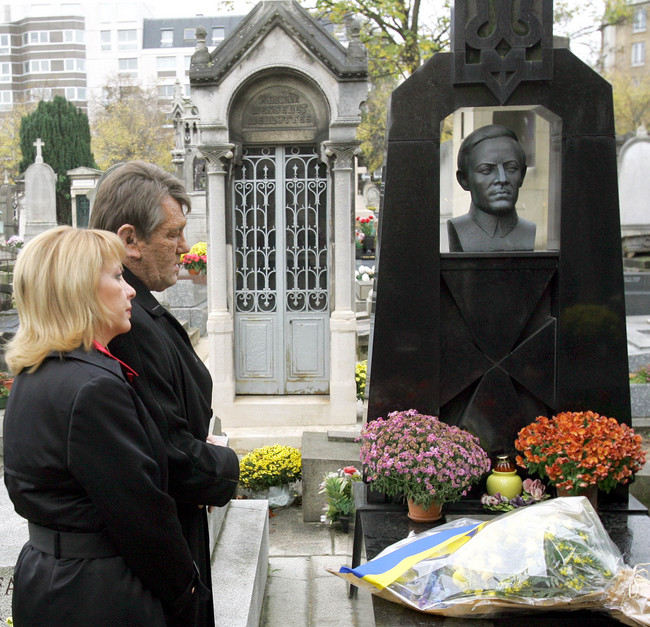
Viktor Yushchenko and Kateryna Yushchenko in Paris, at the grave of Symon Petlura. Montparnasse Cemetery, November 16, 2005. Source: Wikimedia Commons
In post-Maidan Ukraine the Revolution of 1917-21 has gained new actuality; it is now often seen as a precursor to the ‘Revolution of Dignity’ of 2013-14. One aspect of this renewed actuality is the re-emergence of the national martyrdom discourse after the shooting of the Maidan activists on 20 February 2014, drawing direct parallels between the Heavenly Hundred and the Kruty heroes.8 In a self-sacrificial battle in the village of Kruty on 29 January 1918 a group of several hundred Ukrainian soldiers, many of them students, suffered heavy losses trying to stop superior Bolshevik forces which were approaching Kyiv. As Uilleam Blacker noted, ‘Kruty was referenced in a much-photographed piece of graffiti on the Maidan, just near the end of Instytuts’ka Street, where many young men died fighting government forces: ‘Nashi Kruty tut’ – Our Kruty is Here.’9 In the post-Maidan years, the heroic myth of Kruty, which had earlier been appropriated by Svoboda and other nationalist groups, moved into the mainstream public discourse, education and memory politics.
In today’s public debate, historians and intellectuals underline the parallels between the two revolutions and call on politicians and society to learn the ‘lessons’ from the events of 1917-21.10 From this perspective, both historical events are structurally similar because the anti-colonial, national liberation aspirations of Ukrainians and their attempt to create their own state are again, as one hundred years ago, thwarted by Russian aggression. Once again, Ukraine is facing the threat of losing its independence to Russia. Lessons to be learned thus concern the importance of building effective state institutions and a strong military, counteracting the danger of populism, overcoming antagonisms among the Ukrainian elites and, of course, formulating an adequate response to Russian aggression. The latter, as noted for example, by the Director of the Institute of National Memory, Volodymyr Viatrovych, deploys the same arsenal of weapons as a century ago:
Obviously, only those experts who did not study the history of 1917-18 can consider ‘hybrid war’ a new form of aggressive military operations. The methods of Putin’s occupiers are similar to what Bolsheviks did a hundred years ago: creating parallel puppet ‘state bodies’ and then sending them military help. In this way, external aggression appears as ‘internal civil war’ and ‘support to a brotherly people’.11
Viatrovych went even further on a separate occasion, speaking about the Ukraine’s ‘hundred-year war for independence’:
‘One hundred years ago the fight for Ukraine started. It started with a Russian aggression, with the attack by the Bolsheviks on Ukraine. Accordingly, we can talk about a Russian aggression which started one hundred years ago and still continues today. Unfortunately, we can talk about Ukraine’s hundred-year war for truth, for freedom, which still continues. And the outcome of this hundred-year war depends the extent to which we learn the lesson from our predecessors. And to what extent we remember the fight of our predecessors.’12
The official commemoration of the 100th anniversary of the Ukrainian Revolution in 2017 has thus gained new political accents against the background of the ongoing conflict with Russia. On 22 January 2016, the Day of Ukrainian Unity,13 President Poroshenko signed a decree14 which declared 2017 the Year of the Ukrainian Revolution 1917-21 and made its commemoration a priority of state memory politics for the following five years. In his public speech on the occasion of this memorial day, Poroshenko referred to his decree and stressed that one hundred years ago the ‘lack of national unity in the face of the threat from Moscow led to the loss of independence. This is a severe lesson for all of us. I demand from both the coalition and the political opposition as well as from extra-parliamentary forces to learn it. As President I will not allow the mistakes of the past to be repeated’.15
Poroshenko’s decree entrusted the Ukrainian government with the task of developing a comprehensive commemorative programme, which was presented at a press conference held on 13 March 2017 by the vice prime-minister of Ukraine, Pavlo Rozenko, the state secretary of the Ministry of Information Politics of Ukraine, Artem Bidenko, and the director of the Institute of National Remembrance (UINP), Volodymyr Viatrovych. Among other activities announced at the press conference was the erection of a monument dedicated to national unity (sobornist) and a monument to Symon Petliura in Kyiv, a public information campaign by the UINP which will travel through the regions, an all-Ukrainian search project ‘Sites of memory of the Ukrainian Revolution of 1917-21’ which will result in a special database and the memorialization of revolution events in local communities; a special website; a collection of songs of the Ukrainian Revolution, as well as a thematic board game for children. As noted by Bidenko, the aim of these measures is to integrate the Ukrainian Revolution into mass culture, not just into school curricula.
On March 16, 2017, the National Museum of the History of Ukraine opened the exhibition ‘One Hundred Years of the Ukrainian Revolution. The State Regained’ which marked the beginning of the Year of Revolution. The exhibition presented artefacts and official documents, stamps and banknotes from the UNR and ZUNR era, military decorations and uniforms of the UNR and the Ukrainian Galician Army. At an official meeting on this occasion, Poroshenko underlined the historical importance of the Ukrainian Revolution, citing the famous historian Ivan Lysiak-Rudnytsky, but also talked also about the ‘cold shower of history’ for today’s Ukrainian politicians. He called them not to celebrate but rather analyse the mistakes of their predecessors which led to the loss of independence. Among the reasons for this failure Poroshenko cited ‘wrong ideological orientations, such as hopes for federation with Russia and support for socialist and communist doctrines, which instead of consolidation fuelled class and social hatred between different groups in Ukrainian society and thus made it vulnerable in the face of the external enemy.’16 As for other reasons for the failure of the revolution, the President mentioned the absence of a real, professional Ukrainian army and the lack of international support. However, the main reason, he believed, was the lack of internal unity, permanent political conflict, intrigues and anarchy.
Volodymyr Viatrovych, speaking at the same meeting, noted that from the foreign policy perspective, the Ukrainian Revolution cannot be overestimated because it proves that modern Ukrainian state had in fact been born 100 years earlier (in the same way as the Finnish or Czechoslovak states) and not just emerged by chance due to the collapse of the Soviet Union – as it is often claimed by Russian politicians. The popularization of the knowledge about the Ukrainian Revolution of 1917-21 abroad would thus help counteract Moscow’s anti-Ukrainian propaganda.
While the above-mentioned exhibition (and President Poroshenko’s speech at its opening) emphasised state building as the most important aspect of the 1917-21 Ukrainian Revolution, another exhibition – called ‘The Brave Ones: Our Heroes’ (Vidvazhni: Nashi Heroi) – actually celebrated the rebellion and the heroic figure of the Ukrainian rebel throughout the 20th century.17 This exhibition was organized by the UINP and the Museum of the Revolution of Dignity (still in progress), and was presented in the Ukrainian House in Kyiv on November 21, 2016, the day commemorated as the beginning of the Euromaidan protests. In January and February 2017 it was shown in the Globus shopping mall on the Maidan and later travelled to the Ukrainian regions. This project, the organizers argued, sought to present ‘images of Ukraine’s freedom fighters throughout the 20th to 21st centuries’ as a demonstration of continuity in the nation’s fight for independence and as a commemoration of the fallen heroes. The exhibition focused on six episodes from Ukrainian history – the Ukrainian Revolution of 1917-21, the Kholodny Yar Republic,18 the Ukrainian Insurgent Army, the Granite Revolution, the Orange Revolution and the Revolution of Dignity – thus building a continuity between the Ukrainian ‘century of revolutions’ and integrating post-Soviet mass protests into the narrative of Ukraine’s fight for independence.
The juxtaposition of the two above-mentioned exhibitions demonstrates how the meaning of ‘revolution’ in today’s Ukrainian political context oscillates between rebellion against an (alien) state and the building of (one’s own) state. This tension remains at the heart of today’s Ukrainian drama of national survival. At the same time, the original socialist tradition of the Ukrainian Revolution of 1917-21 – and the leftist political agenda on the Maidan – is absent in the public representations of both historical events. Why?
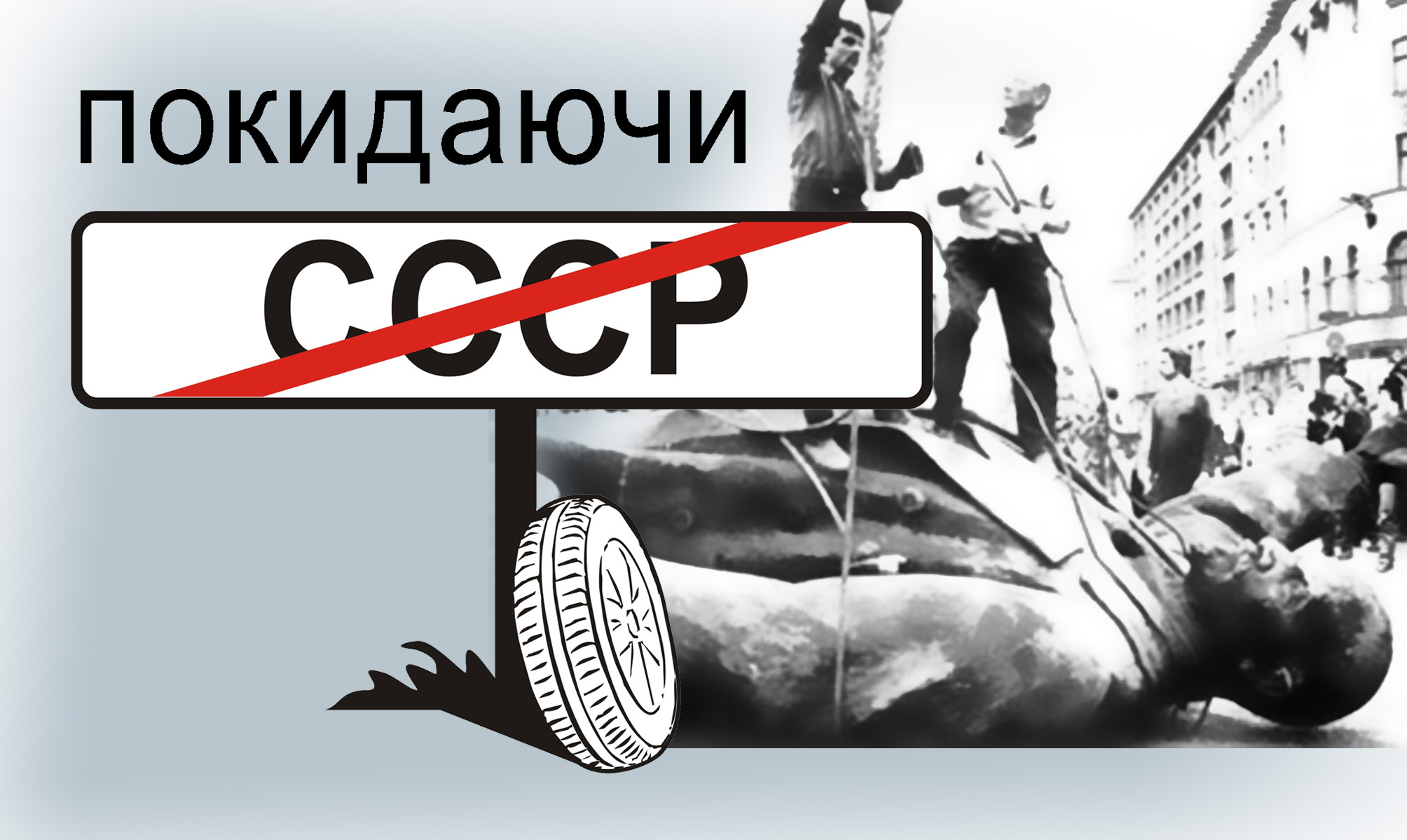
‘Leaving the USSR’: a fallen Lenin statue with a sign against which a car tire leans, as a symbol of the Maidan. Decommunization material provided by the Ukrainian Institute of National Remembrance (UINP). Source: UINP
2. Unmaking the ‘Soviet century’: Decommunization in the context of the Maidan and the Russian aggression
The making of the new myth of the Ukrainian Revolution 1917-21 means at the same time the unmaking of (what is left from) the old Soviet myth of the Bolshevik Revolution of 1917, which for more than 70 years served as the founding myth of the USSR. So-called decommunization is at the heart of this two-fold process. The newest wave of public debate on decommunization was triggered by the four memory laws adopted by the Ukrainian parliament in April 2015. Particularly relevant for the subject of this essay is the Law No. 317-VIII ‘Оn the Condemnation of the Communist and National-Socialist (Nazi) Totalitarian Regimes in Ukraine and Prohibition of Propaganda of their Symbols’.19 In this section I will not, however, go into a critical review of the memory legislation and its practical implementation.20 The pitfalls of both decommunization and its criticism have already been explained perfectly by Oxana Shevel:
‘(…) the fundamental dilemma in Ukraine’s decommunization process is how to undo the legal, institutional, and historical legacy of the Soviet era without repeating the Soviet approach of mandating one ‘correct’ interpretation of the past and punishing the public expression of dissenting viewpoints. This dilemma is further complicated by the fact that criticism of the decommunization laws has come both from intellectual circles in the West and in Ukraine that are genuinely concerned with upholding freedom of expression and fostering free historical inquiry, and from retrograde forces in Ukraine and Russia concerned first and foremost with keeping Ukraine in the Russian sphere of influence and preserving the Soviet era memory regime with its assessments of events, groups and individuals.’21
My intention here is to assess what is left from the myth of the Bolshevik revolution in today’s Ukraine and to show how the Maidan and the subsequent Russian aggression have contributed to the further de-legitimation of the Soviet narrative, thereby providing the post-Maidan government and the Institute of National Remembrance with the political arguments for decommunization. I am also arguing that by externalizing the Soviet experience as ‘occupation’, the policy of decommunization excludes socialist and communist traditions from Ukrainian history. It further marginalizes those left political forces which still cling to the Soviet past, but also urges the younger generation of the Ukrainian left to re-invent itself.
To be precise, decommunization started with Ukraine obtaining independence. Today, we are witnessing its third wave. The first wave took place after the first free elections in 1990. In 1991 the still-Soviet Ukrainian parliament adopted the law ‘On Rehabilitation of Victims of Political Repressions in Ukraine’.22 After the August 1991 coup in Moscow the Communist Party was outlawed; only in 1993, when the ban was lifted, was the Communist Party of Ukraine recreated under the leadership of Petro Symonenko. Otherwise, the decommunization of the early 1990s was limited to its symbolic dimension and practiced very unequally in the regions. In western Ukraine, where the Narodnyi Ruch movement won the majority in the local councils, decommunization was swift and radical and went hand in hand with the Ukrainization of the urban landscape. In most other parts of Ukraine and especially in the east, decommunization only led to the renaming of a few streets – partly because returning to pre-revolutionary toponyms was easier in historical city centres and practically impossible in the new industrial suburbs, and partly because the Communists and their political allies quickly regained power in the local councils and stopped the renaming process. Hence, in the east and south, decommunization was rather selective and quickly dropped.
Ukraine experienced a second wave of decommunization after the Orange Revolution of 2004. Viktor Yushchenko believed that national memory could be ‘cleansed’ of what he considered foreign colonial narratives. One of his political priorities was the commemoration of the 75th anniversary of the Holodomor, which the Ukrainian parliament declared a genocide of the Ukrainian people. The Ukrainian Security Service (SBU) launched a criminal investigation into the organisers of the man-made famine, and in January 2010 the Kyiv Court of Appeals declared Stalin and some other Bolshevik leaders guilty of ‘deliberately organising a genocide of a part of the Ukrainian national group, which resulted in the killing of 3,941,000 persons’.23 The narrative of the Great Famine as the ultimate crime of the Communist regime in Ukraine left little space for the old pantheon of Bolshevik leaders and heroes of the civil war. A decree of President Yushchenko from 2009 explicitly ordered the ‘dismantling of memorials and memorial signs devoted to persons involved in the organization of the Holodomors and political repressions’.24 At that time, the decree of the outgoing president was largely ignored. Only when a wave of decommunization from below started in 2013-14 was this decree used by Ukrainian activists and local authorities for legitimizing the ‘wild’ toppling of monuments.
Soon after taking office Victor Yanukovych revoked central elements of his predecessor’s memory politics, e.g. the thesis of the Holodomor as genocide or the heroization of the UPA. Some critics saw his politics as a ‘re-Sovietisation’.25 Indeed, in the east, and especially in the Donbas, Soviet symbols, working class pride and the victory in the Great Patriotic War became cornerstones of regional identity in opposition to the ‘Ukrainian nationalism’ allegedly imposed from Kyiv. At the same time a de facto, non-ideological decommunization continued under the pretext of ‘modernizing’ the urban space (in reality often replacing ‘outdated’ Soviet symbols with Orthodox ones).26
The third wave of decommunization was initiated by the new Ukrainian government after the fall of Yanukovych and is often considered to be yet another attempt to accomplish what was not achieved after the Orange Revolution. Moreover, the failure to complete decommunization in 2005-2010 is seen by the initiators and supporters of the 2015 memory laws as one of the main causes of the current crisis: in their eyes, the residual enclaves of Soviet memory and Soviet mentality had become the nurturing ground for the ‘Russian spring’.27 But despite a certain continuity, the decommunization launched in 2015 has been taking place in a completely new political context which has endowed it with additional legitimation against the widespread criticism it had experienced from inside and outside the country. The Maidan protests all over Ukraine and the subsequent dismantling of Lenin statues (‘Leninfall’) – a movement from below, which was supported by nationalists as well as liberals – gave the official politics of decommunization strong backing. And even more importantly, the Russian aggression against Ukraine and the use of Soviet symbols for pro-Russian mobilisation turned decommunization into an issue of national security and helped the government to legitimize it in the eyes of the public.
It is in this context that in June 2015 the Communist Party of Ukraine was stripped of its right to participate in elections and later in the same year was officially banned on charges which included supporting the annexation of Crimea by Russia and providing support to pro-Russian separatists, both acts of treason against the Ukrainian state. The ban on the Communist Party of Ukraine – a party of pro-Russian Soviet nostalgists with Lenin still as its figurehead – has ended the almost century-long presence of communists in Ukrainian politics and revealed the deep crisis of the Ukrainian left.
It is a barely noticed paradox of decommunization in Ukraine that, in order to be finally removed, Soviet statues had first to be revived, brought back to life from the ranks of dead objects, in other words, to be ‘re-politicized’. After being treated merely as part of the natural landscape, an element of the ‘cultural heritage’ (especially during the Yanukovych era), with the Maidan they acquired a whole range of new political meanings. Originally symbols of the Bolshevik Revolution, they appeared at the peak of the Maidan uprising as symbols of power, and toppling a Lenin statue became the symbolic gesture of anti-authoritarian revolt. As noted by one of the left commentators in December 2013, Lenin himself being an anti-authoritarian revolutionary would probably have approved of the dismantling of his monuments. For the majority of the younger generation of the Ukrainian left, however, toppling Lenin monuments looked like an act of appropriation and monopolization of the Maidan by Ukrainian nationalists and the far right, denying any space for a left alternative on the Maidan. And for some anti-Maidan activists, especially in the east, Lenin statues becoming a target of revolutionary vandalism made them symbols of local history and markers of local identity which required protection from the Maidan and later from the ‘junta’ in Kyiv. With the Russian aggression in spring 2014 these monuments therefore became also a site and symbol of pro-Russian mobilization – a fact that, on the other side of the ideological divide, contributed to their perception as symbols of Russian colonial power once again seeking to subjugate Ukraine.
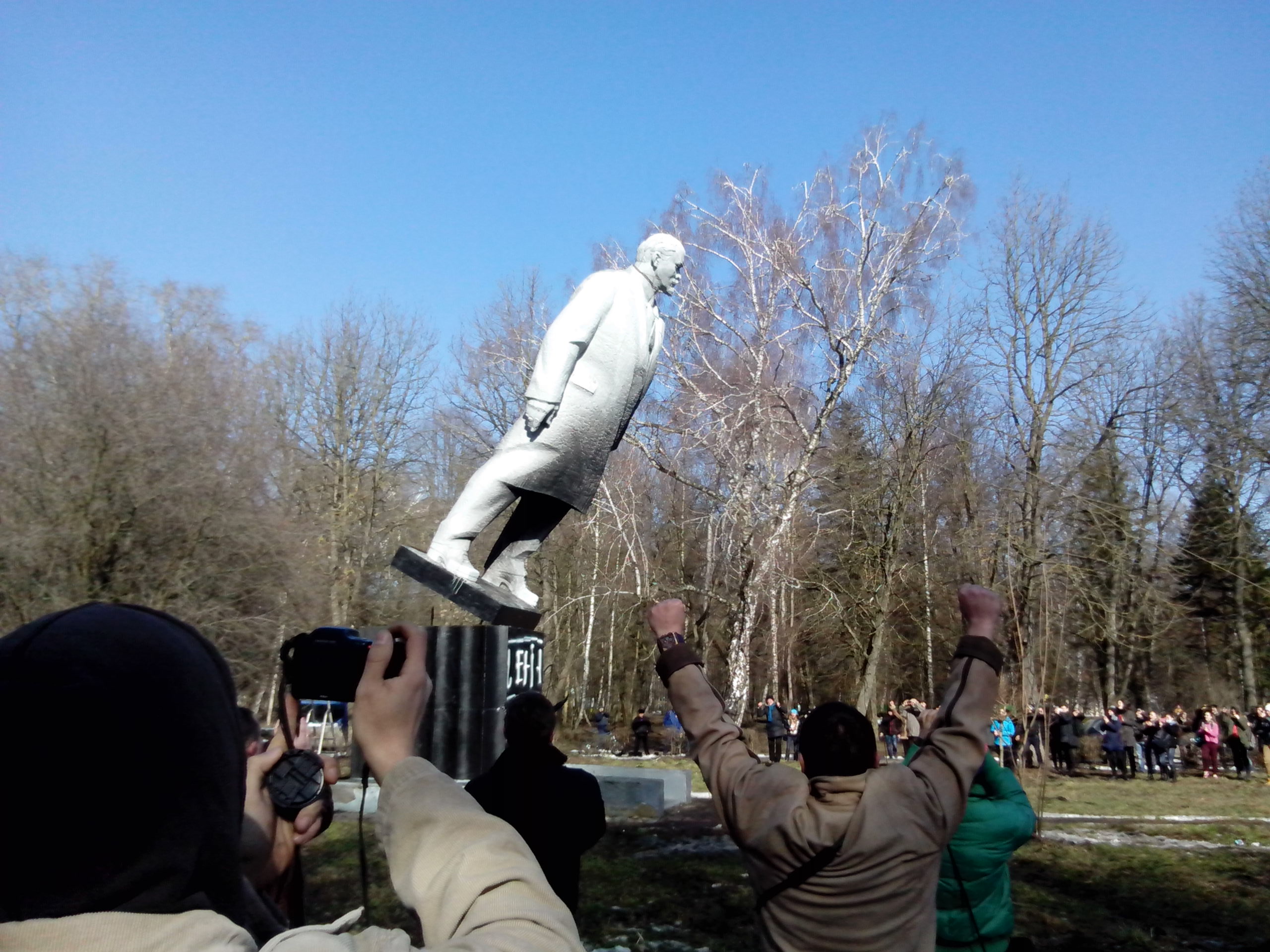
A statue of Lenin is pulled down in a park in Khmelnytskyi, 2014.
Source: Wikimedia Commons
For many left-minded critics of decommunization the Soviet symbols banned by the new legislation refer to the positive heritage of Soviet economic and cultural modernisation and, more importantly, to the idea of economic and social justice which gained new actuality with the rise of post-Soviet oligarchic capitalism. The total ban on Soviet symbols excludes not only Russian Bolshevism but also Ukrainian indigenous socialist and leftist traditions, groups and leaders from public space and intellectual debate. By ignoring Ukrainian Bolshevism and denying the early Ukrainian SSR its nation building role, the politics of decommunization reduces the ‘Ukrainian 20th century’ to the narrative of national victimhood. And retroactively, the politics of decommunization reduces the Maidan – a broad mass movement which included anti-oligarchic, egalitarian and left liberal agendas – to merely a conservative revolution in the name of the Volk and the church.
In general, the Maidan revolution became a challenge for the Ukrainian new left, with different groups taking rather different attitudes towards this event: for some, who identified with the Maidan, supported it and took active part in the protests, the Revolution of Dignity had the potential of a broad social movement for social justice and human rights, against oligarchic capitalism and the corrupted political system.28 The Maidan, from this point of view, was in principle open to leftist agenda even if the space for it had to be fought for, sometimes in direct confrontation with the nationalists and far right. As argued by Vasyl Cherepanyn,
‘(…) from the discursive point of view, the Maidan might have looked like a nationalist protest, but from the perspective of its everyday grassroots functioning it was an autonomous communitarian commonwealth (avtonomna kommunitarna spilnota). Bonds of solidarity, protesters’ friendships, modes of cooperation and mutual help, self-organization and the readiness to be immediately engaged depending on the situation – we, so to say, watched the materialization of a utopia in the centre of Kyiv. What the left theoreticians have been dreaming and writing about was suddenly made true by ordinary people, who did not read these books.’29
The Maidan, from this perspective, was a pro-European, and even more, a genuine European movement:
‘Europe as a potential for change, democratic emancipation and political self-rule was newly founded at the Maidan. Europe returned to Maidan as democracy in the original, antique sense – as a power of the demos against the oligarchy.’30
The Maidan is thus comparable with recent protests in Europe and other regions (Occupy, the Indignados, the Arab Spring, etc.) and thus is an international, not just national phenomenon. This part of the Ukrainian left has been trying to explain the meaning of the Maidan to the European left and seeking solidarity from them. Other representatives of the new Ukrainian left have been keeping a more critical distance from the Maidan revolution, underlining its ‘dark side’: the role of the far right, violence, exclusion of minorities etc.31 In their eyes, there was no space for leftist politics on the Maidan, which confronted the left with the dilemma of being marginalized or giving up and joining the mainstream. From this perspective, ‘Maidans’ and ‘anti-Maidans’ in Ukraine appear as structurally similar phenomena: protests driven by the same motives despite a different political rhetoric. For many from this segment of the Ukrainian left, the Maidan is little more than an oligarchic revolution and a far-right, nationalist revolt manipulated by both US and Russian interests. The kind of Europe these leftists appeal to is the anti-EU Europe of the anti-globalist and anti-American radical left.
Still yet other leftists in Ukraine openly expressed solidarity with the ‘anti-Maidan’, took a pro-Russian position in the conflict and even claimed that a genuine socialist revolution took place in Donbas aimed against the Kyiv oligarchs. Inspired by anti-Americanism, they were seeking, for their part, to mobilize radical European (and Russian) leftists in support of the self-proclaimed ‘people’s republics’.32
Indeed, as their conflict with the post-Maidan government unfolded, the pro-Russian Donbas rebels were relating to Soviet symbols and the working class ethos of the local population, and evoking US capitalism and Kyiv oligarchs as their enemies. Particularly interesting in this context is the attempt of the self-proclaimed ‘Donetsk People’s Republic’ (DNR) to establish historical continuity with the Donetsk-Kryvyi Rih Soviet Republic (DKR) of 1918, a short-lived rival of the UNR. On 6 February 2015, the DNR issued the Memorandum ‘On the basis of state building, political and historical continuity’, proclaiming the DKR as a historical precedent for their project.33 The DNR also tried to revive the myth of ‘Artem’ (Fyodor Sergeyev), a Bolshevik leader from Kharkiv and a co-founder of the DKR. In the Soviet period, ‘Artem’ was a local Bolshevik icon in Donbas and Kharkiv (the former capital of the DKR), but in the course of decommunization his statues were removed and streets bearing his name renamed.
To evoke historical continuity with the DKR entails an implicit territorial claim for Kharkiv and other Ukrainian territories and signifies a left ideological alternative to Kyiv’s ‘nationalism’. However, as Andrew Wilson has rightly noted, the DKR is a problematic symbol: ‘It was a ploy in Lenin’s shifting calculations as Ukrainian, German and Bolshevik forces fought over Ukraine.’34 At the time, the DKR stood in the way of another, more promising project of the Bolsheviks – the Ukrainian Soviet Republic – and was eventually dissolved by Lenin. ‘The myth of the DKR therefore had little place in the local consciousness’35 and hence is of little use for the ‘founding fathers’ of the DNR who prefer to rely on the Great Patriotic War memory and Russian nationalism. The further away from the ‘Russian spring’, the less relevant becomes the initial revolutionary rhetoric and the hopes for social justice associated by some idealists to the self-proclaimed ‘people’s republics’. Even if the Soviet myth had demonstrated some residual symbolic power in the anti-Kyiv protests in spring 2014, it was probably the last time that the spectre of the Bolshevik Revolution will haunt the post-Soviet space.
3. Conclusion
It might seem that the drama of the revolution and the civil war of 1917-21 has been restaged in today’s Ukraine, but history never repeats itself and historical parallels in most cases serve political purposes. While Lenin desperately needed Ukrainian wheat and coal for the economic survival of the Bolshevik state, Putin’s obsession with Ukraine is more related to the realm of geopolitical phantasms and imperial nostalgia. True, some vices of Ukrainian state building seem to persist through history, but post-Maidan Ukraine certainly possesses a vibrant civil society and strong national identity strengthened under the pressure of external aggression. Despite decades of Soviet rule – but partly also due to Soviet nationality politics – the idea of an independent Ukrainian state is deeply rooted in popular consciousness and accepted by the international community.
The global political constellation a hundred years later is different, too. Bolshevik Russia, once the bearer of a revolutionary universalist project, is now the stronghold of a new conservatism and a supporter of anti-European nationalist and populist movements. While the big communist utopia is dead and a new alternative to global capitalism is not in sight, the project of a liberal and democratic Europe is also under threat. The Maidan revolution, almost a century after the European revolutions of 1917-18 and a quarter of a century after the fall of the Iron Curtain in 1989, is looking for its place in the European political imagination which is shaped by these two great European revolutionary moments and two political projects – the anti-capitalist and the anti-totalitarian ones. The failing of the first one leaves us today deprived of a left alternative to global capitalism; the second one marks the peaceful end of a political despotism that had emerged from this very alternative a century ago. Communism failed, and from its ruins rose the idea of a liberal world order – if only, one might meanwhile think, to prove to be the next illusion.
With its pathos of pro-European enthusiasm, belated decommunization and naive liberalism, the Maidan revolution appears for many as the coda to the 1989 moment, almost an anachronism in a new era marked by a crisis of the liberal order and the threat of European disintegration. For others, the Maidan adds to the ‘left-wing melancholia’36 – one more ‘wrong’ revolution which proves the disappearance of utopia as the horizon of politics. But how much time has to pass until a revolution can be assessed? The French historian Francois Furet once noted in regard to the French Revolution that it has a beginning, but no end as it ‘contains a promise of such magnitude that it becomes boundlessly elastic’.37 In this sense, the Maidan Revolution might still have a long history ahead of it. What one can say for sure is that it sheds a new light on the events of 1917 and the ‘Soviet century’ – not only in Ukraine, but also in Russia and Europe.
November 12, 2017
See the report about the conference ‘February. Tragedy. Lessons of History. 1917’ held in the Cathedral of Christ the Saviour in Moscow on 18 February, 2017: Pavel Skryl’nikov, ‘The Church reminded the Liberals of the 1917 “Maidan”’, Nezavisimaya Gazeta, 1 March 2017 (in Russian), www.ng.ru/ng_religii/2017-03-01/14_416_maidan.html.
The ‘Granite Revolution’ was the first peaceful protest against the Communist leadership. On 2 October 1990 students occupied the Maidan in Kyiv, at that time ‘October Revolution Square’.
For a concise history of Ukraine see Andreas Kappeler, Kleine Geschichte der Ukraine, Munich: C.H.Beck 2014.
See: www.memory.gov.ua/.
Yaroslav Hrytsak, Essays in Ukrainian History: The Making of the Modern Ukrainian Nation, Kyiv: Heneza 1996 (in Ukrainian).
Vladyslav Verstuk, Vitaliy Skal’skyi, ‘The Ukrainian Revolution of 1917-21 in the politics of national memory during 2007-2010’, in: R. Pyrih (ed.), Problems in historical research on the Ukrainian Revolution 1917-1921, Kyiv: Institute of the History of Ukraine NANU, 2010, p. 17 (in Ukrainian).
‘In Lozova vandals destroyed the memorial cross dedicated to UNR soldiers’, Gazeta.ua, 30 January 2009, https://gazeta.ua/articles/life/_u-lozovij-vandali-znischili-pamyatnij-hrest-vstanovlenij-na-chest-voyiniv-unr/280630 (in Ukrainian).
Uilleam Blacker, ‘Martyrdom, Spectacle, and Public Space: Ukraine’s National Martyrology from Shevchenko to the Maidan’, in: Journal of Soviet and Post-Soviet Politics and Society, vol. 1, no. 2 (2015), p. 257-295.
Ibid. p. 286.
See for example ‘1917. Revolution as a warning. Lessons of the events of 100 years ago in contemporary Ukrainian context’, in: Den’, 16 February 2017, www.day.kyiv.ua/uk/article/tema-dnya-podrobyci/1917-revolyuciya-yak-zasterezhennya.
Ibid.
‘Institute of National Remembrance is starting an information campaign for the 100th anniversary of the Ukrainian Revolution 1917-1921’, official website of the Cabinet of Ministers of Ukraine, 13 March 2017, www.kmu.gov.ua/control/uk/publish/article?art_id=249805754&cat_id=244276429.
The day when the UNR and ZUNR signed the Unification Act back in 1918.
Decree of the President of Ukraine No. 17/2016 «On Commemoration of the 100th anniversary of the events of the Ukrainian Revolution 1917-21», official website of the President of Ukraine, 22 January 2016, www.president.gov.ua/documents/172016-19736.
Appeal of the President of Ukraine on the occasion of the Day of Unity of Ukraine, official website of the President of Ukraine, 22 January 2016, www.president.gov.ua/news/zvernennya-prezidenta-ukrayini-z-nagodi-dnya-sobornosti-ukra-36643.
Head of State: ‘Only united we are invincible’, www.president.gov.ua/news/glava-derzhavi-tilki-koli-mi-yedini-mi-neperemozhni-40442.
Multimedia exhibition project «The Brave Ones: Our Heroes», see http://memory.gov.ua/announce/18-sichnya-28-lyutogo-multimediinii-vistavkovii-proekt-vidvazhni-nashi-geroi.
Founded by peasant rebels, the Kholodny Yar Republic existed from 1919 to 1922 on the territory of the UNR. They fought against both the Whites and the Bolsheviks. The leaders were arrested in 1922 by the Cheka and later executed. They were rehabilitated in 2016.
The Law of Ukraine No. 317-VIII ‘Оn Condemnation of the Communist and National-Socialist (Nazi) Totalitarian Regimes in Ukraine and Prohibition of Propaganda of their Symbols’, 9 April 2015, http://zakon2.rada.gov.ua/laws/show/317-19.
See the discussion on the memory laws by Ukrainian and international historians and intellectuals on the website of Krytyka (in 2015): ‘The Future of Ukraine’s Past’, https://krytyka.com/en/solutions/featured/future-ukraines-past.
Oksana Shevel. ‘The Battle for Historical Memory in Postrevolutionary Ukraine’, in: Current History, no. 115 (2016), p. 258-63, p.263.
The Law of Ukraine No. 962-XII from 17 April 1991, ‘On Rehabilitation of Victims of Political Repressions in Ukraine’, http://zakon2.rada.gov.ua/laws/show/962-12.
‘Ruling of the Kyiv Court of Appeal in the Criminal Proceedings over Genocide in Ukraine 1932/33’ from 13 January 2010, http://khpg.org/en/index.php?id=1265217823.
Decree of the President of Ukraine No. 432/2009 from 12 June 2009 ‘On Additional Measures to Commemorate the Victims of the Holodomor 1932/33 in Ukraine’, http://zakon5.rada.gov.ua/laws/show/432/2009.
Mykola Riabchuk, Gleichschaltung: Authoritarian Consolidation in Ukraine 2010–2012, Kyiv: K.I.S. Publishing 2012, p. 168.
Tatiana Zhurzhenko, ‘Erinnerungskonflikte. Gedenkpolitik im postsowjetischen Charkiv’, in: Osteuropa, no. 4 (2015), pp. 153-171.
Cf. Igor’ Mel’nik, ‘Belated decommunization: The problem of emancipating from Soviet mentality was discussed in Kyiv’, Den’, 23 May 2016, https://day.kyiv.ua/ru/article/politika/zapozdalaya-dekommunizaciya.
Examples are the magazine Krytyka Polityczna (http://politicalcritique.org) and the Visual Culture Research Center in Kyiv (www.vcrc.org.ua/en).
Vasyl Cherepanyn, ‘Maidan: the Return of Europe’, in: Politychna Krytyka, no. 5 (2014), p. 6.
Ibid.
See for example, Spilne/Commons, no. 9 (2015), ‘Maidan: A View from the Left’.
Aleksandr Wolodarskij, ‘Borotba: Ukrainian “communists” working for Surkov’, http://reftlight.euromaidanpress.com/2016/11/22/borotba-ukrainian-communists-working-surkov/.
Vladimir Dergachev, Dmitriy Kartsev, ‘The DNR found its history’, www.gazeta.ru/politics/2015/02/06_a_6402557.shtml.
Andrew Wilson, ‘The Donbas in 2014: Explaining Civil Conflict perhaps, but not Civil War’, in: Europe-Asia Studies, no. 4 (2016), p. 631-652, p. 635.
Wilson, ibid, p. 636.
Cf. Enzo Traverso, Left-Wing Melancholia: Marxism, History, and Memory, New York: Columbia University Press 2017.
François Furet, Interpreting the French Revolution, chapter ‘The Revolution is over’, Cambridge UP 1981, p. 3.
Published 30 November 2017
Original in English
First published by Osteuropa 6-8/2017 (in German) / Eurozine (in English)
Contributed by Osteuropa © Tatiana Zhurzhenko / Osteuropa / Eurozine
PDF/PRINTPublished in
In collaboration with
In focal points
Newsletter
Subscribe to know what’s worth thinking about.
Related Articles
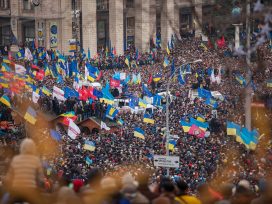
Throughout its recent political upheavals, Ukraine has looked to Europe as a beacon of liberal democracy. Yet Europe has been unwilling to reciprocate, as it did with other countries in the socialist bloc. This has held back not only Ukrainian development, argues Andrii Portnov.
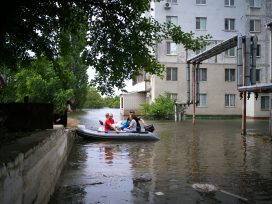
The Ides of March
Ecocide in Ukraine
The immediate need for environmental protection and reparation in war-torn Ukraine has entered the country’s peace plan. Legislative revisions, recognizing ecocide, and thereby advancing the rule of law globally, expand what it means to develop responsible governance of the ecosystems that sustain us.

